Try something new for the Mid-Autumn Festival with the puff pastry mooncake known as Dan Huang Su, featuring flaky layers of pastry crust stuffed with a sweet filling and salted duck egg yolk.
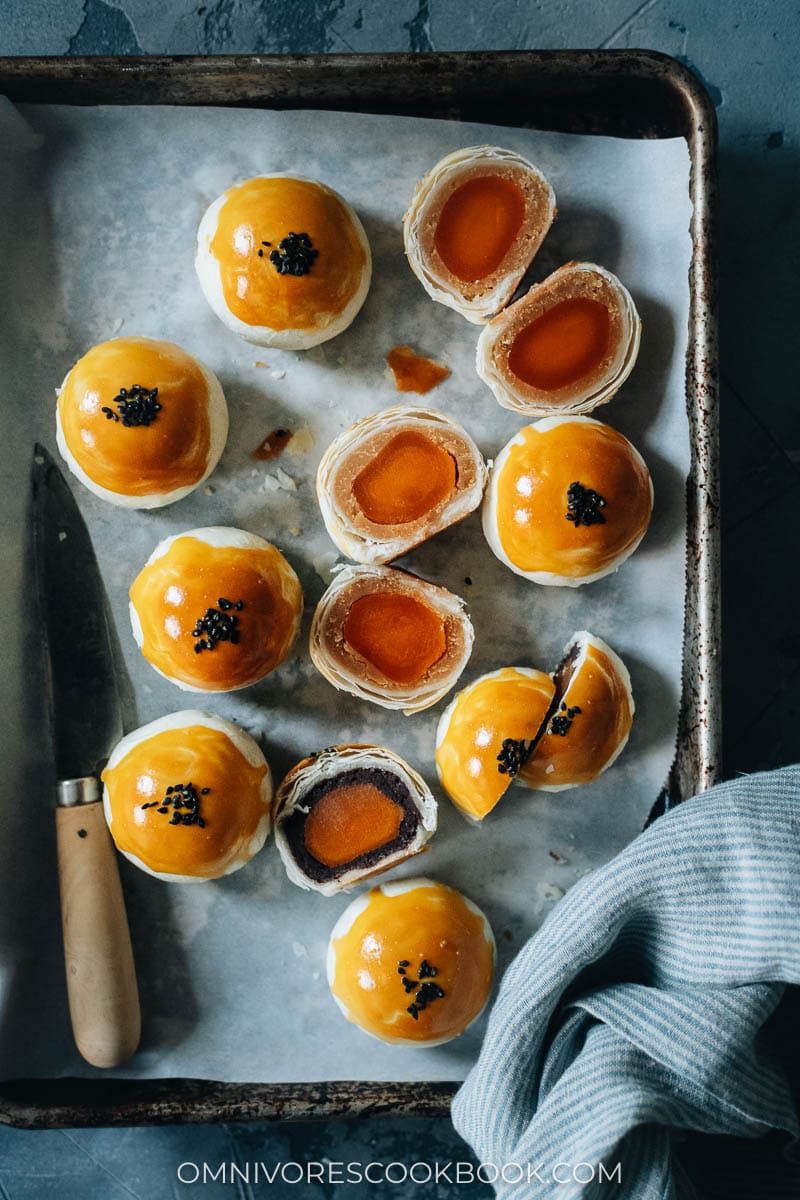
I love traditional Chinese mooncakes for the holidays. But there’s also a special place in my heart for the trendier, more modern and hip versions that are out there today. Dan Huang Su is a wonderful treat that uses a pastry surrounding to encase sweet fillings. Usually, it’s lotus seed paste or red bean paste along with a nice salted duck egg yolk.
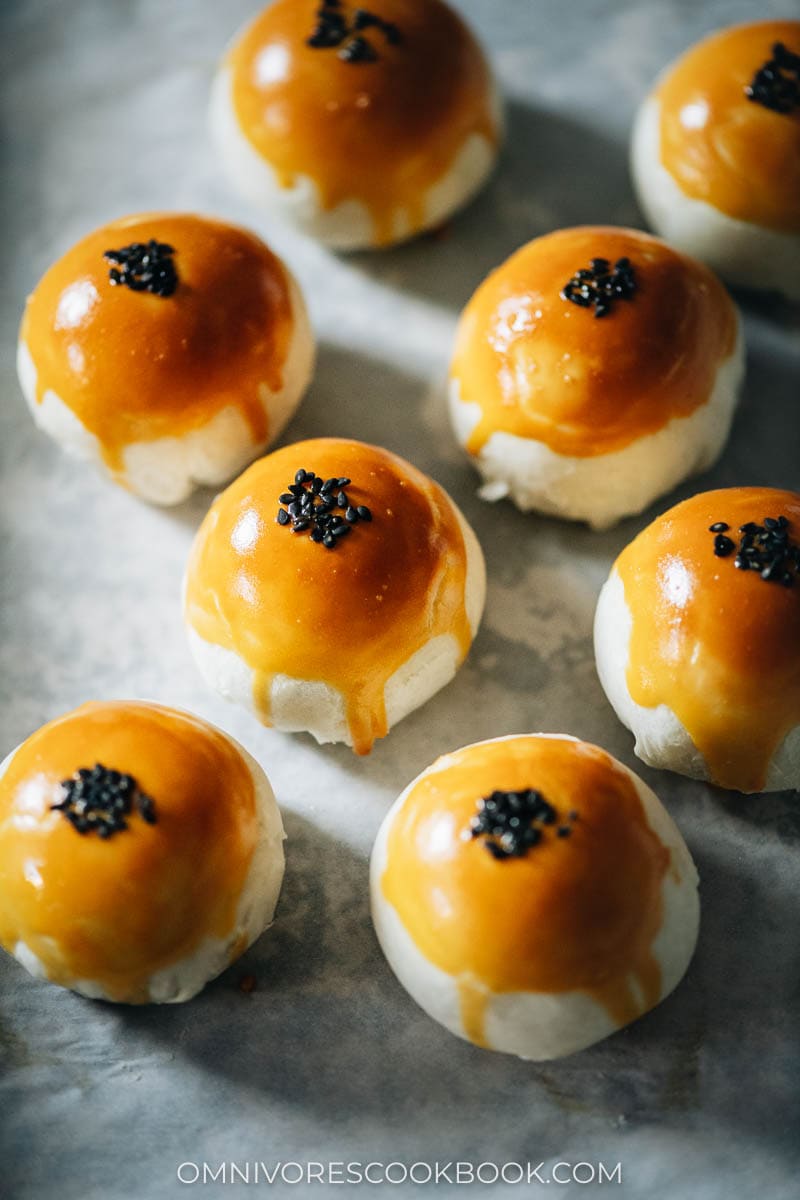
A trendy modern mooncake
The texture of Dan Huang Su is fun with its flaky dough and sticky filling, plus that chewy egg yolk. It’s very buttery, lightly sweet yet salty, and I just love snacking on them (maybe a little too much!).
If I’m honest, I like this pastry even more than traditional mooncakes because it’s got all the essence of a mooncake, but it’s much lighter. Mooncakes are really dense. Dan Huang Su is tastier too.
Back when I was living in Beijing, my family would always serve Dan Huang Su during the Mid-Autumn Festival instead of the traditional mooncakes. These also make a perfect gift because they’re really pretty and easy to store. You can keep them at room temperature for 4 to 5 days, and in the fridge they’ll last about 2 weeks.
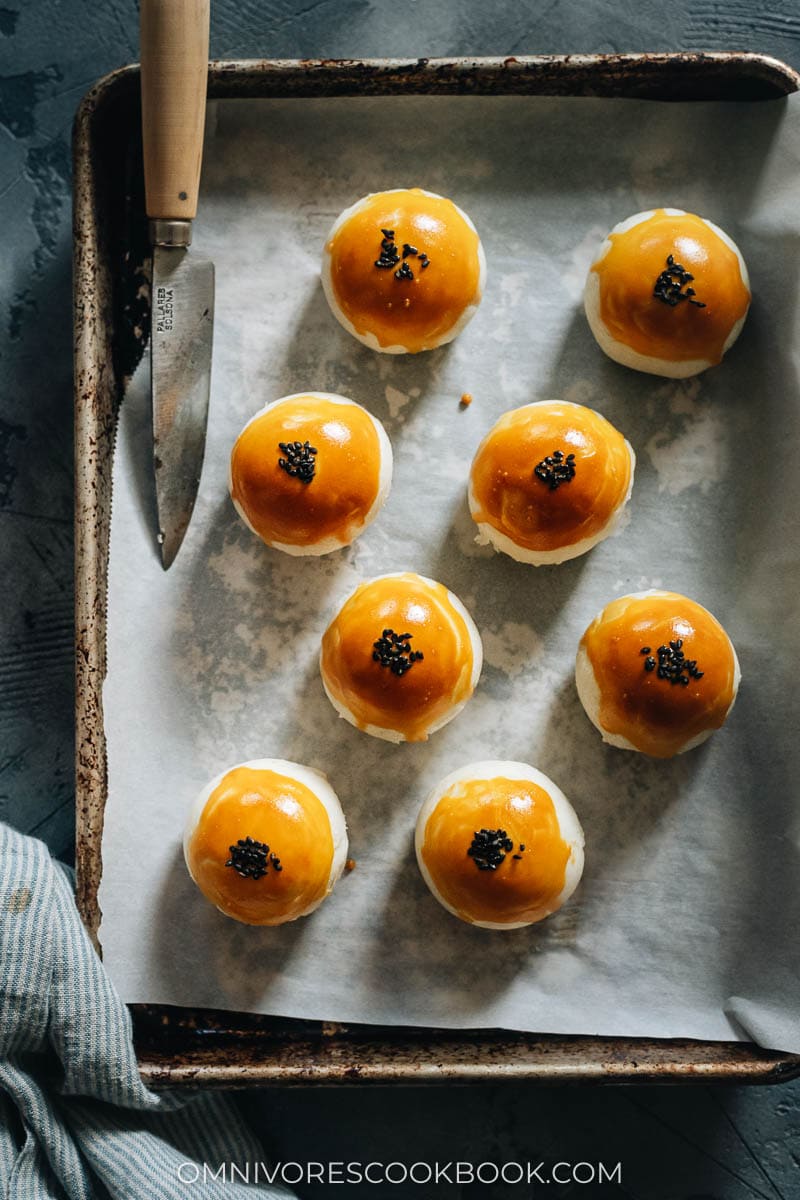
Read this first
Making Dan Huang Su is an undertaking that will require a fairly large chunk of time. I suggest making them on the weekend or whenever you have enough downtime to allow for the process.
The dough is really easy to put together if you have a stand mixer. It has very common ingredients that you should already have on hand, too, unlike with traditional mooncakes. Pastry dough may sound a bit daunting to make, but I promise this one is very easy to work with. You don’t need to cool it like regular pastry dough, so you’ll save loads of time.
One thing you can’t skip, though, is a kitchen scale. You will need precise measurements in order for your Dan Huang Su to come out just right.

Ingredients
Filling options
The fillings of red bean paste and lotus seed paste are easy to make, too. You can follow my recipes to make them at home, which will yield tastier Dan Huang Su, but if you prefer, you can always pick them up ready-made at an Asian market near you or even order it from Amazon.
I always make my own filling though, because it has a fresher taste and is less sweet, giving more balance to the pastries overall. Store-bought red bean paste in particular tends to have more moisture, which can tamper with the dough’s ability to bake properly.
Salty duck egg yolk
The salty duck egg yolk is the highlight of the recipe. You can find the packaged yolks at many Asian market refrigerated sections. They are already pre-cooked and ready to use.
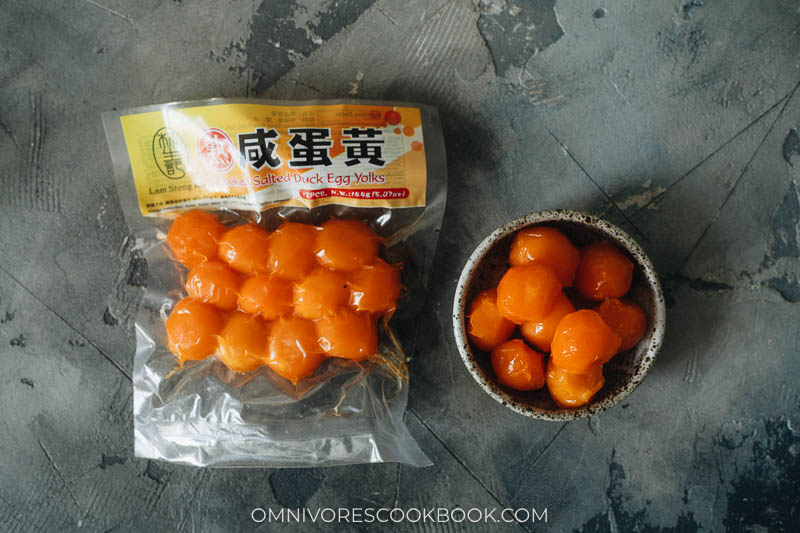
Alternatively, you can also buy the uncooked whole salty duck eggs. In this case, you will need to bake them before using them in the pastries. The cooking method is in the recipe footnote.
If both of the options above are unavailable, you can also purchase the cooked whole salty duck eggs on Amazon. These eggs can be stored at room temperature so they might be easier to find. To use them in this recipe, you will need to peel the eggs and remove the egg whites to get to the yolk.
Dan Huang Su Cooking process
The major feature of Dan Huang Su is the flaky layered crust. To make it, you will need to make a water dough and an oil dough, then roll and fold them repeatedly to create the layers.
Part 1 – prepare the water dough
- Sift the flour
- Add other dry ingredients
- Mix everything together with a spatula
- Knead the dough in a mixer
- If the dough flattens on the bottom (because your mixer is too big), you’ll need to stop it and re-attach the dough
- To do this, scrape the dough from the bottom and attach it to the dough hook
- When the dough is ready, you can stretch it out to a semi-transparent pane
- Cover the dough with plastic wrap and let rest
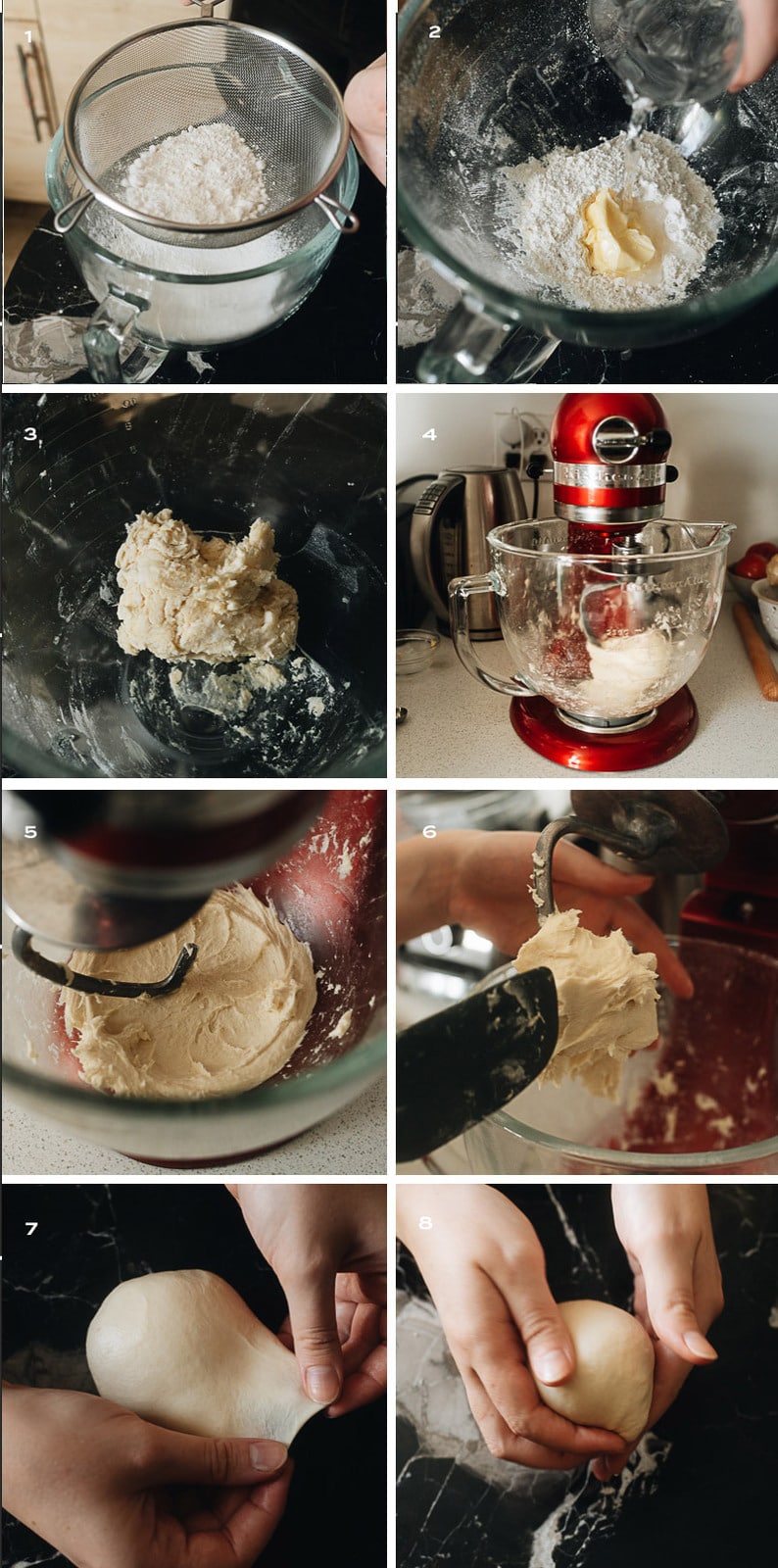
Part 2 – prepare the oil dough
- Mix the flour with the shortening
- Use your fingers to work the shortening into the flour
- Shape the dough into a square
- Cover the dough with plastic wrap until ready to use
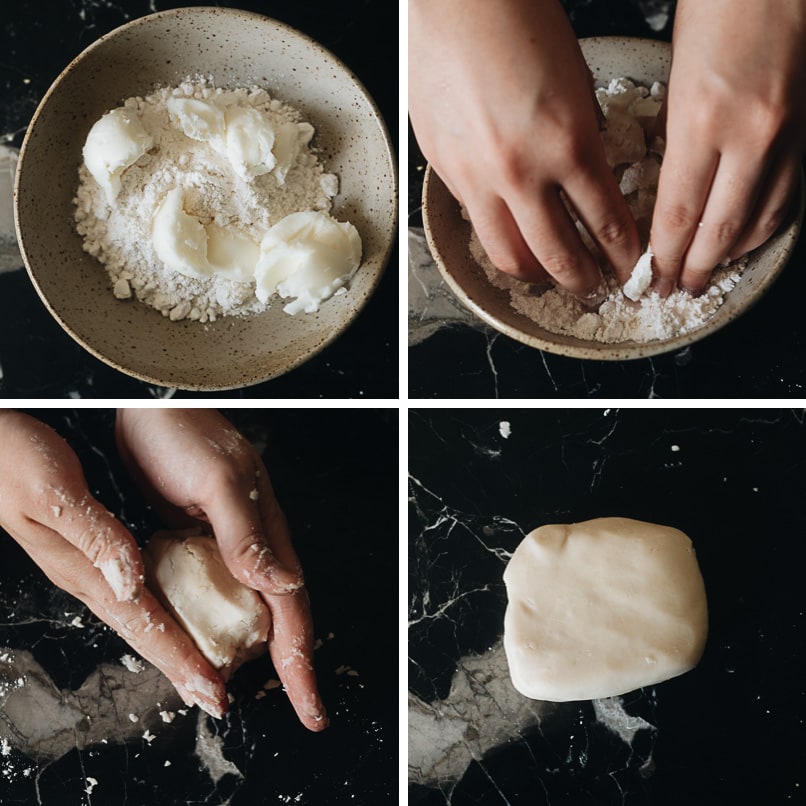
Part 3 – make the filling
To make the filling, take a scoop of the paste (red bean or lotus seed), flatten it out, then wrap the salty duck egg yolk in the middle.
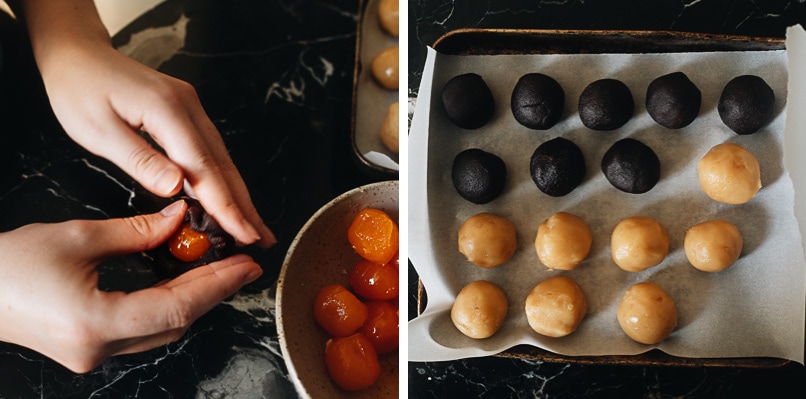
Part 4 – assemble the pastry dough
- Cut and measure the water dough
- Gently shape it into dough balls and cover
- Cut and measure the oil dough
- Shape and cover the oil dough balls

Part 5 – prepare the mooncake crust
The pastry dough is super fun and easy to work with.
- Use your hands to flatten the water dough
- Place the oil dough on top
- Wrap the oil dough in the water dough and form a ball
- Roll the dough ball into a long, flat strip
- Fold and roll up the strip
- Roll out the strip again into a long strip
- Roll up the strip one more time
- Cover up all the rolled strips
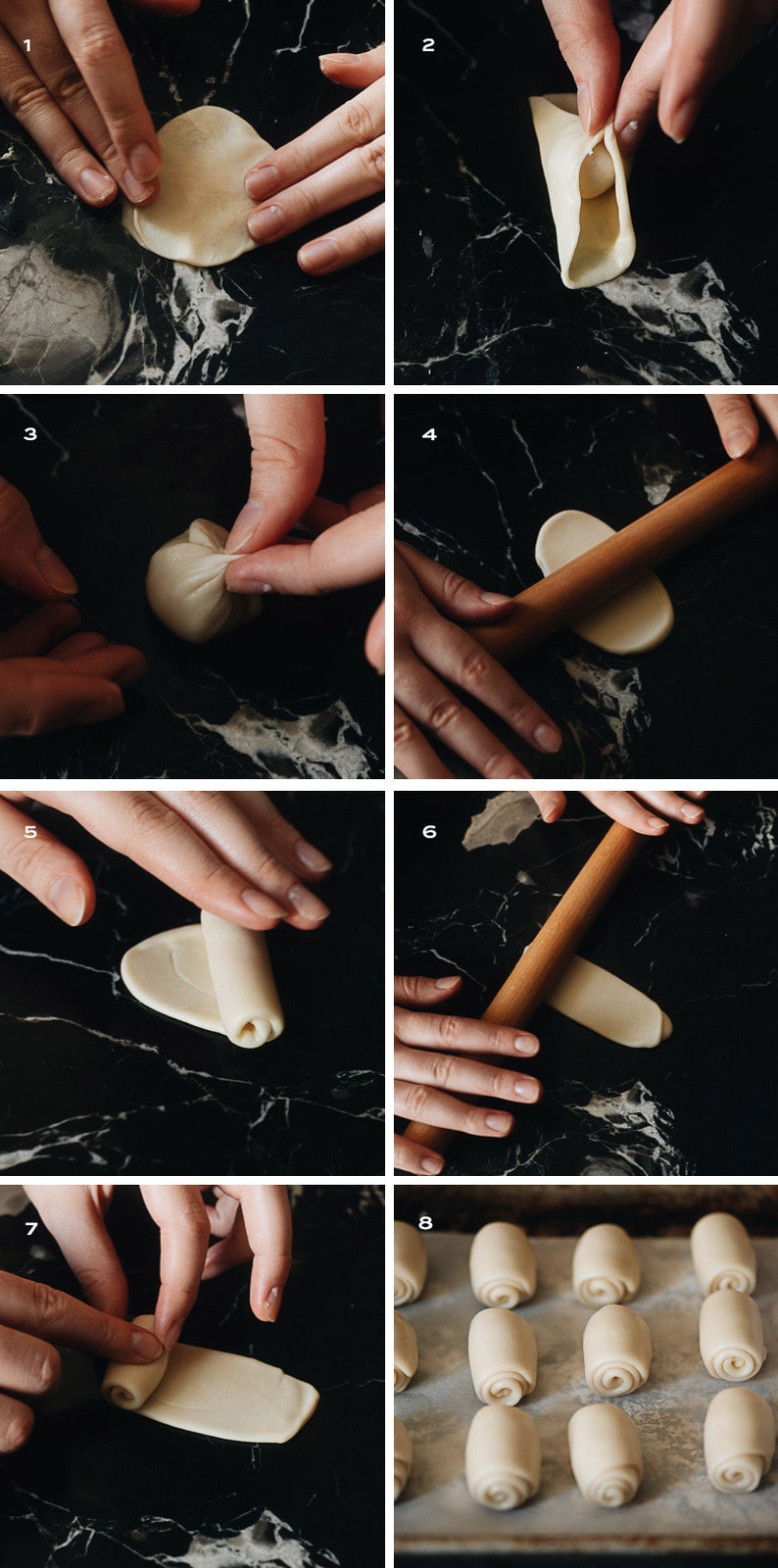
Part 6 – assemble the mooncake
- Use your finger to press the middle of the rolled dough strip
- Bend the strip so the swirl sides are facing up
- Press down on the swirled sides
- Roll out the dough into a flat disk
- Place the filling on top
- Wrap the filling with the dough
- Use your hands to gently shape it into a ball
- Brush the top twice with egg yolk wash
- Add the sesame seeds for garnish
- Bake until golden brown
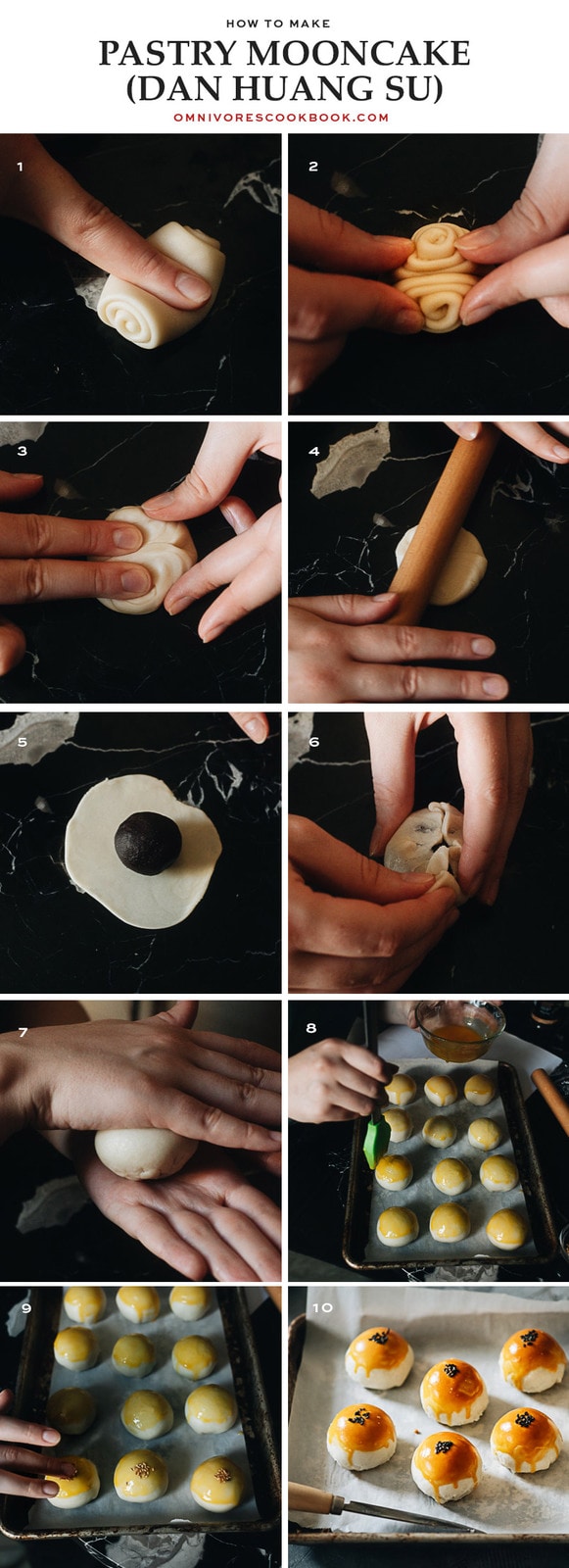
That’s it!
It may sound like a lot of work, but these mooncakes are so fun to make and the result is super rewarding. These pastries are a great variation on the traditional mooncakes and they are super delicious to enjoy year-round.
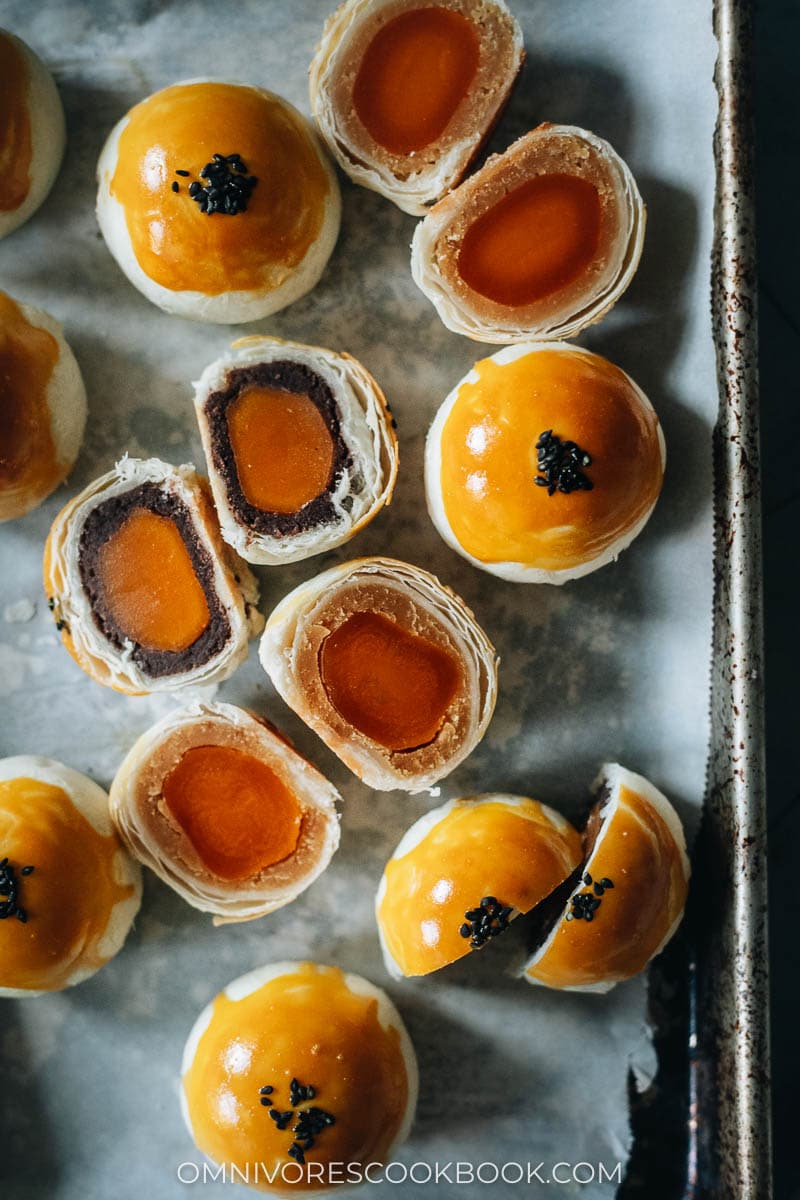
In any event, I hope you’ll give Dan Huang Su a try and put it on your Mid-Autumn Festival menu this year!
Want to learn more about Chinese Cooking? Sign up my newsletter to receive the 5-Day Chinese Cooking Crash Course and recipe update!
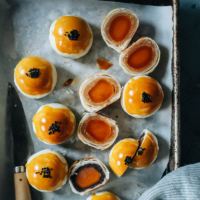
Dan Huang Su (Pastry Mooncake with Salty Egg Yolk, 蛋黄酥)
Ingredients
Water Dough
- 70 g all-purpose flour
- 20 g low-gluten flour (pastry or cake flour)
- 12 g (1 tablespoon) powdered sugar
- 1/8 teaspoon salt
- 35 g unsalted butter , softened
- 40 ml ice water
Oil Dough
- 110 g low-gluten flour (pastry or cake flour)
- 55 g shortening
Filling
- 16 salted duck yolks (*Footnote 1)
- 400 g homemade red bean paste (or homemade lotus seed paste) (*Footnote 2)
Wash
- 2 to 3 egg yolks
- Black sesame seeds
Instructions
Make water dough
- Sift the water dough flours, sugar, and salt into the bowl of a stand mixer. Add the butter and ice water. Mix with a spatula until a rough dough forms. Place the bowl in the mixer with the dough hook attachment. Drape a piece of the dough over the hook. Turn the mixer to setting 4 and knead until smooth and elastic, about 10 minutes. Depending on the size of your mixer, it may be necessary to stop the kneading occasionally and lift the dough over the hook (*Footnote 3). To test the dough, stretch it into a thin semi transparent sheet and it should hold well. Knead in the mixer for a bit longer, if needed. Once done, cover the dough and rest for 10 minutes.
Make the oil dough
- Combine the low-gluten flour and shortening in a medium-sized bowl. Mix and press it together using your hands, until dough shapes. Further shape and knead it on a working surface until uniform and smooth. Cover and rest for 5 minutes.
Make the filling
- Divide your choice of filling paste into 25g balls. Flatten each ball into a 2.5”(6.5 cm) disc and place a yolk in the center. Gently press the paste around the yolk to cover the yolk completely. Try to press out any air bubbles and prevent from damaging the yolk. Once the yolk is fully covered, roll it between your hands to smooth it out until it forms a smooth ball.
Prepare the pastry dough (*Footnote 4)
- Divide the water dough into 16 even pieces, 10 g per piece. Work on one dough at a time, use your hands to pull the dough towards the center, until it forms a ball. Pinch to seal the end and set aside. Always cover the dough with plastic wrap.
- Divide the oil dough into 16 even pieces, 10 g per piece. Form each piece into dough balls using your hands and cover them.
- Flatten a ball of water dough with your palm and spread it with your fingers so that the center is thicker than the edges, about 2.5” (6.5 cm) wide. Place a ball of oil dough in the center. Lift the edges of the water dough over the oil dough to wrap it and pinch at the top to seal it. Set it aside and cover it. Repeat with all pieces of dough.
Assemble
- Preheat the oven to 350°F (176°C).
- Take a formed ball, sealed-side down, and flatten it with your palm. Gently roll it into a 5” (12.5 cm) long strip. Flip it over so it’s seam-side up. Starting from the short side, roll it into a thick jelly roll. Turn the roll 90° and flatten it with your hand. Again roll it into a 5”(12.5 cm) strip and then into a jelly roll. Cover and set aside. Repeat with the remaining balls.
- Beginning with the first roll you made, take a roll and press into the middle so the swirled ends are pressed out. Then fold the swirled ends into the center and press them down so that a flat disc is formed. Roll this disc out so that it is 5” (12.5 cm) in diameter. Place the filling in the center. Lift and stretch the dough over the paste ball to cover completely, and pinch to seal. Roll between your palms to smooth it out. Repeat with all the dough and cover all the dough pieces with plastic wrap as you do so. (*Footnote 5)
- Line a baking tray with parchment paper. Place the pastries on it, at least 1” (2.5) apart.
- Lightly beat the yolk. Brush a thin layer of the egg wash onto the tops of the pastries. Wait 5 minutes and brush with a second layer of yolk.
- Wet your fingertip with water and dip it into the sesame seeds so the seeds stick to your finger. Tap the top of each pastry to decorate.
- Bake at 350°F (176°C) for 15 to 20 minutes, until the egg wash turns golden and the pastries are cooked through and flaky. Once done, remove from the baking sheet from the oven and let cool for 15 minutes before serving.
Storage
- After completely cooling, you can store the baked mooncakes in an airtight container at room temperature for up to 4 days, in the fridge up to 2 weeks, or in the freezer for 3 months.
Notes
- If you plan to use raw egg yolks, you’ll need to bake them before wrapping them into the mooncakes. Preheat the oven to 325°F (162°C) and line a baking tray with foil. Spread the yolks on the tray and sprinkle with a small amount of alcohol, such as vodka or baijiu. Bake for 8 minutes then allow to rest to cool completely.
- I prefer the homemade version because it’s less sweet and will make a more balanced pastry once you are done baking.
- If your stand mixer is too big for the dough, the dough may flatten on the bottom after kneading for a while. You’ll need to lift the dough onto the hook and restart again.
- You can store the dough and the filling before shaping the mooncakes.
- You can store the assembled uncooked mooncakes and bake them later. To store, wrap each mooncake with plastic wrap and place it in a ziplock bag. Store in the fridge for 1 week or in the freezer for 3 months. To bake the mooncake, let it thaw in the fridge, if frozen. Then brush with egg wash and garnish it with sesame seeds before baking.
Video
Nutrition
If you give this recipe a try, let us know! Leave a comment, rate it (once you’ve tried it), and take a picture and tag it @omnivorescookbook on Instagram! I’d love to see what you come up with.
Other mooncake related recipes
- Snow Skin Mooncake with Custard Filling
- The Ultimate Guide to Traditional Mooncake
- Homemade Golden Syrup (转化糖浆, Invert Sugar Syrup)
- Kansui (lye water, alkaline solution, 枧水)
- Homemade Lotus Seed Paste (莲蓉馅)
- How to Make Red Bean Paste
Lilja Walter is a part of the Omnivore’s Cookbook team and worked closely with Maggie to develop and test this recipe.













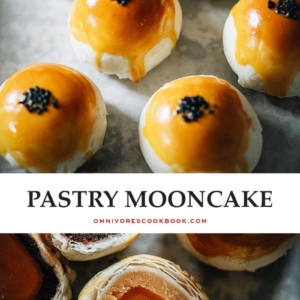
Hi,
I have questions about using raw egg yolks in this recipe. The Notes say to bake the raw yolks (?) for 8 minutes. Will the yolks be fully cooked after the 8 minutes? I only have access to chicken egg yolks right now. How much baijiu do I need to add?
Also, how do I store the mooncakes after baking? How big is the final product?
What if I wanted to incorporate other fillings like wu-ren 五仁? Can this dough be used for non-mooncake fillings a la xie ke huang蟹壳黄?
Thanks!
The raw salty yolk itself is not as soft as regular yolk. After 8 minutes it will be cooked and ready to use in the pastry. You want the yolk to be stiff enough to work with but not overcooked and dry (because you will need to bake again after wrapping the pastry). I don’t have a baijiu amount because it’s just a very thin layer of brushing. I guess 1 to 2 teaspoons?
The final baked mooncake is about 2″ in diameter and 1.5″ tall.
I’m pretty sure wu-ren 五仁 filling works. Xie ke huang蟹壳黄 is a bit tricky because the filling is very soft. This recipe produces a very soft dough and this shaping method is designed for a shapable filling. If you’re using Xie ke huang, I’m pretty sure you will have to use a different shaping method and baking time. I cannot confirm the result without testing. (I’ll look into this direction but probably won’t release the recipe for a while)